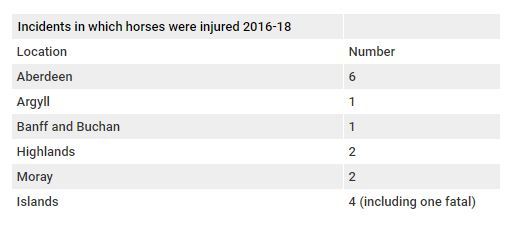Six drivers were caught in less than two hours in an undercover police road safety crackdown in Aberdeenshire.
Motorists who pass too close to horses were being targeted as part of a national police campaign to reduce the number of injuries and deaths on roads.
The Lose the Blinkers drive is aimed at all road users but particularly those on the fringes of large rural towns where many horse riders stable and exercise their animals.
The Press and Journal gained exclusive access to the plain-clothed operation as two members of the Police Scotland Mounted Unit rode through Banchory – with one wearing a helmet-camera to film any incidents.
On patrol were Stewarton, ridden by PC Jennifer Weir and Lewis, ridden by PC Simon Wilson.
The worst cases of careless driving could be taken to court and result in penalty points or a driving disqualification, but on this occasion the drivers were asked to stop and were given advice on how to pass horses safely.
Sergeant Alan Gilbert, the training sergeant at the Ayr-based mounted unit, followed behind in an unmarked police car driven by PC Calum Jamieson from Inverurie’s roads policing division.
The officers spoke to six drivers in Banchory and advised drivers to pass “wide and slow”.
Sergeant Gilbert said: “Horses are allowed to ride double-file on public roads. Drivers should go over to the other carriageway, give as much space as you would to another car.
“Horses are generally flight animals, but they can quickly become frightened and won’t necessarily run away from a hazard – they may run straight at it.”
The British Horse Society says that since 2010 there have been two rider deaths and 10 horses killed on Scotland’s roads. A total of 50 riders and 43 horses have also been injured.
Many of the incidents have been caused by vehicles either colliding or passing too close to the horse, causing them to throw the rider, panic or bolt.
The Police Scotland campaign, which is supported by the British Horse Society regularly sends plain-clothed officers out patrolling areas of concern and recording incidents of bad driving on camera.
The force’s mounted unit currently stables 20 horses at their base near Ayr and they regularly attend football matches or other policed events that may require public order control.
With 25 police riders making up the team, most have joined because they have previous equestrian experience, but some have under-gone the 16-week intensive training from being complete beginners.
Sergeant Gilbert used to compete in show-jumping events and said: “Non-riders have gone from no experience to being able to walk, trot and canter without stirrups.
“They also jump and have to do a small dressage test. They will never be expected to do show-jumping, but there might come a day when they have to jump a wheelie bin for example or another object on the ground.
“It’s a big ask to take a non-rider to that level. We do find a big drop-out of male students due to groin injuries.
“But if they get through it, they are passed to ride fully-qualified police horses in any situation.”
The horses can be found from different sources, Sergeant Gilbert explained that they can sometimes find new recruits who are for sale online or owners also have approached direct offering suitable candidates.
“They are given a 28-day trial to see if they are deemed suitable and are then fully adopted and trained,” said Sergeant Gilbert.
“We need to know how they will react in large crowds.”
One retired police horse, 19-year-old Mearns, is currently being housed at the World Horse Welfare Centre at Belwade Farm, near Aboyne.
Eileen Gillen, who runs the rescue centre, brought Mearns along to meet up with his old work colleagues.
She said: “He’s fallen right back into full police-mode. They definitely remember each other. We got Mearns a few years ago and found him a home, but he’s recently been returned to us, through a change of circumstance – though we are hoping to re-home him again soon.”
Chief Inspector Murray Main, head of rural crime in the north east, said: “I hope the action taken over the last few days increases awareness of the potential issues for all parties and increases the number of people talking about equestrian safety
“Horse riders represent a significant group of vulnerable road users and we know of occasions where riders have been involved in accidents or near misses on local roads.
“While the numbers of incidents are relatively low I think there are likely to be more incidents that go unreported. We also know this sort of accident can on occasion result in injuries, or worse fatalities, for riders, their horses or both.”
An animal welfare charity has backed the force’s campaign as it called for motorists to be more vigilant when sharing the road with horses
The British Horse Society revealed there had been 16 incidents within the Press and Journal’s publication area over the past two years in which a horse had been injured.
In one of those incidents, the animal sadly died.
A Society spokeswoman said: “It’s great to see Police Scotland take horse and rider safety so seriously.
“In 2016, we launched our Dead Slow campaign in response to the shocking number of incidents involving horses on roads across Britain.
“Over the past 12 months we have seen a slight reduction in Scotland, but the number of incidents is still far too high.”
Across the UK, the charity’s statistics showed there had been eight horses killed and 68 injured in the past year alone.
The organisation has called on drivers to slow down to 15mph when behind horses on the road, be patient and refrain from tooting or revving engines and only overtake when safe ensuring a car’s width is left in between the animal and the vehicle.
